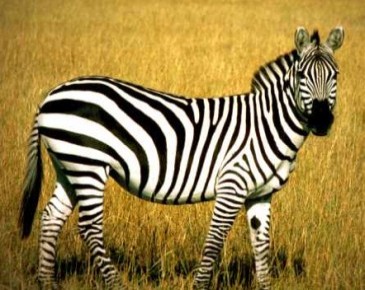 |
| https://targetstudy.com/nature/animals/zebra.html |
The zebra belongs to the Equidae family.
Zebra are the biggest of the wild horses, with a recognisable colour pattern, black and white strips. The strips are different and unique to every single zebra.
In the African savannah there three species:
1. Common Zebra (broad strips)
2. Grevy's Zebra (endangered)(narrow stripes)
3. Mountain Zebra (endangered)(narrow stripes)
All three species are social and can travel long distances in herds in search for resources (water and food).
Their bodies are made for speed to escape predators (40kph) and agility with their long, slim legs and slender hooves. They walk on the top of their hooves, with their single toe. The are able to reach the grass by the adaptation of the long neck. They have a mane running all along their bodies from the tail to the head. They eat vegetation and plant matter, they use the front teeth to tear and nibble of the grass, then the molars to grind the food.
Zebras spend most of their days roaming and feeding (60%-80% of the day feeding) the savannah's and grasslands of Africa. The stallion guards his territory and the females and fouls from any predators. When the mating season comes around the males fight each other for the right to breed by kicking, biting and rearing up.
Females are not sexuality active for the first few years of life. They are slow breeders as pregnancy last ten months and then a further eleven months of weaning the foal. The foals stay close to their mother until the age of three, when the males leave the herd and try and find his own females to mate with and start a herd. Newborn foals are born with strips and a little tuft of hair on their stomach, they are able to stand very quickly after birth, so they are able to escape if predators are near.
A-z-animals.com, (2015). Zebra (Equus zebra, Equus quagga, Equus grevyi) - Animals - A-Z Animals - Animal Facts, Information, Pictures, Videos, Resources and Links. [online] Available at: http://a-z-animals.com/animals/zebra/ [Accessed 7 Apr. 2015].
Zebra are the biggest of the wild horses, with a recognisable colour pattern, black and white strips. The strips are different and unique to every single zebra.
In the African savannah there three species:
1. Common Zebra (broad strips)
2. Grevy's Zebra (endangered)(narrow stripes)
3. Mountain Zebra (endangered)(narrow stripes)
All three species are social and can travel long distances in herds in search for resources (water and food).
Their bodies are made for speed to escape predators (40kph) and agility with their long, slim legs and slender hooves. They walk on the top of their hooves, with their single toe. The are able to reach the grass by the adaptation of the long neck. They have a mane running all along their bodies from the tail to the head. They eat vegetation and plant matter, they use the front teeth to tear and nibble of the grass, then the molars to grind the food.
Zebras spend most of their days roaming and feeding (60%-80% of the day feeding) the savannah's and grasslands of Africa. The stallion guards his territory and the females and fouls from any predators. When the mating season comes around the males fight each other for the right to breed by kicking, biting and rearing up.
Females are not sexuality active for the first few years of life. They are slow breeders as pregnancy last ten months and then a further eleven months of weaning the foal. The foals stay close to their mother until the age of three, when the males leave the herd and try and find his own females to mate with and start a herd. Newborn foals are born with strips and a little tuft of hair on their stomach, they are able to stand very quickly after birth, so they are able to escape if predators are near.
A-z-animals.com, (2015). Zebra (Equus zebra, Equus quagga, Equus grevyi) - Animals - A-Z Animals - Animal Facts, Information, Pictures, Videos, Resources and Links. [online] Available at: http://a-z-animals.com/animals/zebra/ [Accessed 7 Apr. 2015].
No comments:
Post a Comment